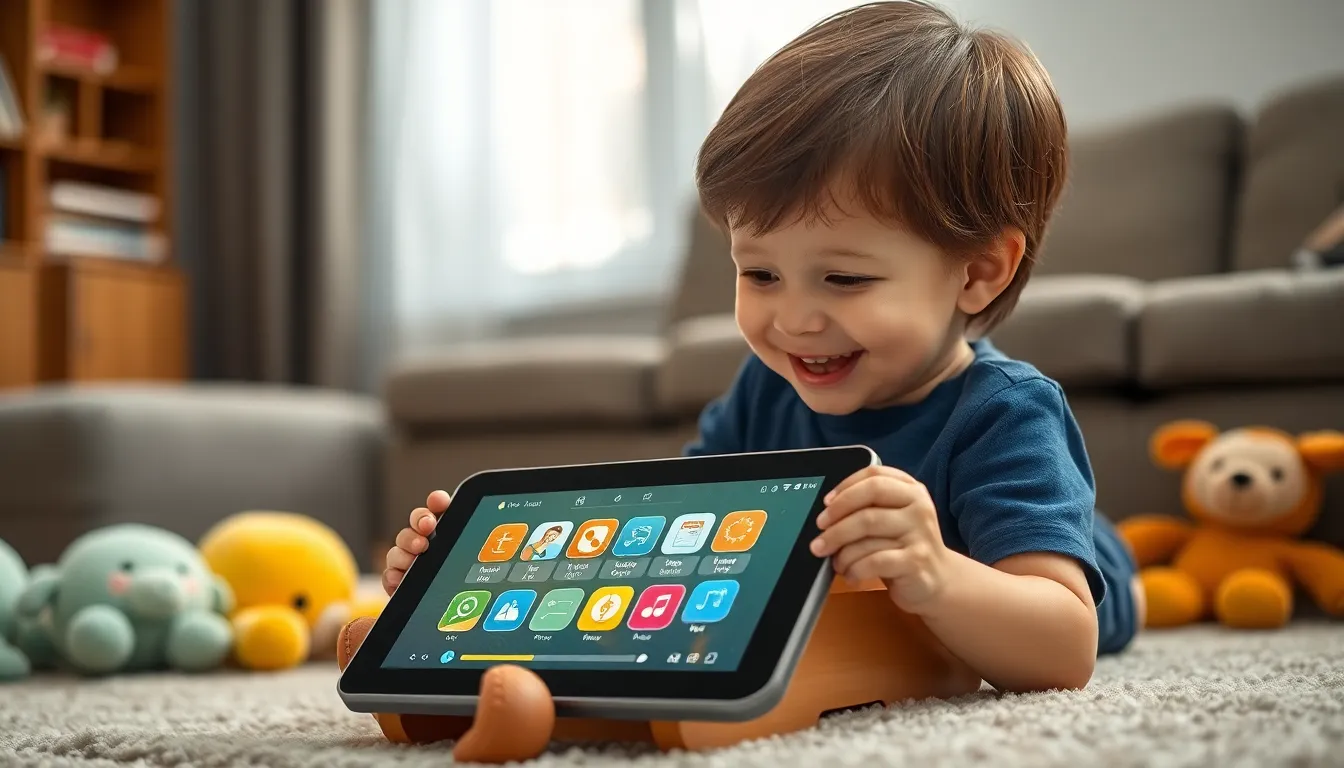In today’s tech-driven world, kids are growing up surrounded by electronics that shape their learning and play. From educational tablets to interactive toys, these devices offer a wealth of opportunities for creativity and skill development. Parents often find themselves navigating a landscape filled with options, each promising to enhance their child’s experience.
Understanding the benefits and potential pitfalls of kids’ electronics is crucial for making informed choices. With the right guidance, these tools can support learning while also providing entertainment. As technology continues to evolve, staying updated on the latest trends and products can help parents foster a balanced approach to their children’s engagement with electronics.
Table of Contents
ToggleOverview of Kids Electronics
Kids’ electronics encompass a range of devices designed to enhance learning and play experiences for children. Common examples include educational tablets, interactive games, and coding kits. These devices aim to engage children while promoting creativity, critical thinking, and problem-solving skills.
Educational tablets come preloaded with apps and learning programs tailored to various age groups. Many offer interactive features that capture children’s attention and cater to different learning styles. For instance, programs may include math challenges, language exercises, and science explorations.
Interactive toys use technology to create immersive play experiences. Products such as robot-building kits and augmented reality games encourage hands-on learning. Children can develop STEM skills through these engaging activities, often without realizing they’re learning.
Parents must acknowledge both the benefits and drawbacks of kids’ electronics. While these devices can foster skill development, excessive screen time may lead to physical and mental health concerns. Setting boundaries for usage is essential.
Staying informed about emerging trends in kids’ electronics helps parents choose appropriate devices. Popular items may include devices featuring parental controls that ensure safe and enriching experiences. Understanding these elements supports balanced technology engagement in children’s routines.
Types of Kids Electronics

Kids’ electronics encompass a wide array of devices tailored to entertain and educate. Key categories include educational devices and entertainment gadgets, each designed to foster learning and creativity.
Educational Devices
Educational devices focus on enhancing learning experiences for children. Examples include:
- Tablets: Equipped with educational apps, tablets like Amazon Fire HD Kids Edition encourage reading and math skills.
- Laptops: The Chromebook for Kids promotes digital literacy with age-appropriate software and parental controls.
- Coding Kits: Products like LEGO Spike Essential teach programming through interactive projects, cultivating problem-solving abilities.
- Interactive Whiteboards: These devices maximize engagement in learning environments, enabling collaborative exercises and interactive lessons.
- STEM Kits: Science, technology, engineering, and math kits provide hands-on learning experiences, supporting systematic thinking and creativity.
Educational devices serve essential roles in developing children’s foundational skills.
Entertainment Gadgets
Entertainment gadgets focus on providing fun and relaxation for kids, combining enjoyment with opportunities for skill development. Examples include:
- Video Game Consoles: Systems like the Nintendo Switch encourage strategic thinking and social interaction through multiplayer gameplay.
- Smart Toys: Toys like Cozmo offer interactive play, featuring coding and problem-solving challenges that enhance cognitive skills.
- Portable Media Players: Devices such as the iPod Touch allow children to access music, audiobooks, and educational videos promoting auditory learning.
- VR Headsets: Virtual reality headsets create immersive experiences that can transport kids to different environments, supporting creativity and exploration.
- Drones: Kids’ drones foster interest in technology and physics, enhancing spatial awareness and coordination during outdoor play.
Entertainment gadgets provide enjoyable avenues for kids while promoting critical thinking and social skills.
Benefits of Kids Electronics
Kids’ electronics offer several significant advantages. They enhance educational experiences while fostering creativity, making them valuable tools for children’s development.
Enhancing Learning
Electronics serve as powerful educational tools that engage children in their learning processes. Educational tablets provide access to age-appropriate apps and interactive programs, making learning enjoyable. Coding kits and STEM kits encourage problem-solving skills through hands-on activities. Interactive whiteboards facilitate collaborative learning, allowing kids to participate actively in lessons. Research indicates that children using educational electronics show improved retention of information and academic performance.
Promoting Creativity
Electronics stimulate creativity by providing various avenues for expression. Interactive toys, like robot-building kits, enable children to construct and innovate, enhancing their engineering skills. Augmented reality games immerse kids in creative scenarios that require critical thinking. Music tablets allow for sound exploration and composition, fostering musical talents. Engaging with these devices encourages imaginative play, which is crucial for cognitive development and self-expression.
Safety and Screen Time Guidelines
Setting safe limits for screen time is crucial for children’s health and development. The American Academy of Pediatrics (AAP) recommends specific screen time guidelines based on children’s age, focusing on the quality of content and engagement.
| Age Group | Recommended Screen Time |
|---|---|
| Under 18 months | Avoid use of screen media, except for video chatting. |
| 18 to 24 months | Use high-quality programming, viewing with a caregiver. |
| 2 to 5 years | Limit screen time to one hour per day of high-quality programs, watching together to promote understanding. |
| 6 years and older | Set consistent limits on time spent using media to ensure it doesn’t interfere with sleep, physical activity, or other essential activities. |
Ensuring a balanced approach integrates physical activity and time for off-screen activities, allowing for physical health and social interactions. Engaging in shared screen time helps foster critical thinking and discussions about content, enhancing learning.
Monitoring content aids in accessing age-appropriate and educational material. Parents can utilize parental controls on devices to restrict unsuitable content, ensuring a safer digital environment. Encouraging breaks during prolonged screen use supports eye health and reduces fatigue.
Promoting a media plan establishes guidelines for overall usage, encouraging children to participate in setting limits on devices. Discussing expectations helps children understand the reasons behind these rules, fostering responsibility and independence in their media consumption decisions.
Top Kids Electronics Products
Numerous kids’ electronics products stand out for their educational value and entertainment. These devices cater to varying age groups and interests, ensuring children engage with technology positively.
Reviews of Popular Devices
- Educational Tablets
- Devices like the Amazon Fire HD Kids Edition tablet feature parental controls and access to numerous age-appropriate apps. They promote learning through interactive games and reading tools.
- Interactive Toys
- Robots such as Cozmo not only entertain, but also introduce basic programming concepts. They engage children in coding challenges, enhancing problem-solving skills.
- STEM Kits
- Kits like LEGO Boost and Snap Circuits encourage hands-on learning. These products allow kids to build robots and electrical circuits, fostering creativity and critical thinking.
- Video Game Consoles
- Consoles such as the Nintendo Switch offer a family-friendly platform for engaging games. These devices provide opportunities for social interaction and cooperative play.
- Drones
- Small drones designed for beginners allow children to explore technology and aviation principles. They promote spatial awareness and coordination while providing outdoor fun.
- Coding Kits
- Products like the Osmo Coding Starter Kit combine physical play with digital learning. They help children grasp coding basics through interactive games and challenges.
- Smart Toys
- Toys such as the Fisher-Price Smart Cycle make learning fun through movement. These toys offer interactive lessons in literacy and math while promoting physical activity.
By selecting these popular devices, parents can facilitate educational engagement and a balanced approach to technology use, enhancing children’s development while ensuring entertainment.
Kids’ electronics play a vital role in shaping modern learning and play experiences. By choosing the right devices, parents can enhance their children’s creativity and critical thinking skills while keeping them engaged. It’s essential to strike a balance between screen time and off-screen activities to promote overall well-being.
Staying informed about the latest trends and incorporating parental controls can help ensure that children benefit from technology without compromising their health. With thoughtful guidance, kids’ electronics can serve as powerful tools for education and development, fostering a generation of innovative thinkers ready to tackle future challenges.





